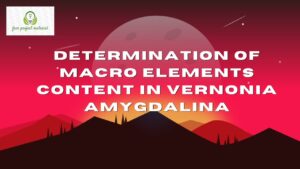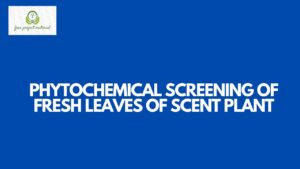ABSTRACT
The analysis for the mineral composition of Vernonia amydalina was carried out using standard analytical method. The result of analysis were as follow; Phophorus 21.00+ 0.01, Potassium 14.50 + 0.01, Magnesium 21.00 + 0.00, Sodium 15.15 + 0.11, Copper 4.30 +3.00, Iron 9.00 + 0.01, and Calcium 18.40 + 0.11. This reveal the sample is rich source of all the analyzed minerals element. Hence, it recommended that Vernonia amydalina leave should be used to enrich human nutrition.
TABLE OF CONTENTS
Title Page – – – – – – – – – i
Certification – – – – – – – – – ii
Dedication – – – – – – – – – iii
Acknowledgements – – – – – – – iv
Abstract – – – – – – – – – v
Table of Contents – – – – – – – – vi
CHAPTER ONE
1.0 INTRODUCTION – – – – – – – 1
1.1 Background of the Study – – – – – – 1
1.2 Aim and Objectives of the Study – – – – 2
1.3 Scope and Limitation of the Study – – – – 3
1.4 Definition of Terms – – – – – – 3
CHAPTER TWO: LITERATURE REVIEW
2.1 Vernonia amydalina – – – – – – 5
2.2 Scientific Classification of Bitter Leaf – – – – 6
2.3 Health Benefits of Bitter leaf – – – – – 7
2.3.1 Phytochemical properties of Vernonia amydalina – – 7
2.3.2 Pharmacological Effect of Vernonia amydalina – – 8
2.4 Types of Minerals – – – – – – – 9
2.5 Functions of Minerals in Food – – – – – 10
CHAPTER THREE: MATERIALS AND METHODS
3.1 Materials – – – – – – – – 14
3.2 Method – – – – – – – – 14
3.2.1 Sample Collection – – – – – – – 14
3.2.2 Laboratory Preparation – – – – – – 14
3.3 Digestion of Sample of Determination of Mineral – – 15
CHAPTER FOUR: RESULTS AND DISCUSSION
4.1 Results – – – – – – – – 16
4.2 Discussion – – – – – – – – 17
CHAPTER FIVE: CONCLUSION AND RECOMMENDATIONS
5.1 Conclusion – – – – – – – – 19
5.2 Recommendations – – – – – – – 19
References
CHAPTER ONE: INTRODUCTION
1.1 Background of the study
Vegetables contain minerals, vitamins, bioactive compounds and phytochemicals, especially antioxidant which help reduce risk of chronic diseases (Caidan et al., 2014; Kumari et al., 2017; Peter et al., 2010). In most countries of tropical Africa, leafy vegetables are consumed in addition to starchy staple foods (Isohola et al., 2017).
Some potential vegetables for human use are not preferred due to bitter taste or unpleasant odor (Ishola et al., 2017) or lack of knowledge about nutritional and medicinal properties. Understandably phytochemical composition and antioxidant potentials of some of these vegetable may encourage their utilization for nutraceutical and pharmaceutical purpose.
Vernonia amydalina commonly known as bitter leaf (English), Etidot (Annang, Efik and Ibibio), Oriwo (Edo), Ewuro (Yoruba), Shikawa (Hausa) and Olubu (Igbo), is a tropical shrub 1-3m in height with petiole leaf of about 6mm in diameter, and elliptic in shape. The leaves are dark green coloured with a characteristic odour and a bitter taste. The species is indigenous to tropical Africa and mostly found in Akwa Ibom and other Southern parts of Nigeria. It is found wild or cultivated all over sub-saharan Africa (Bosch, 2005). The leaves are eaten, after crushing and washing thoroughly to remove the bitterness (Mayhew and Penny, 2008).
All parts of the plant are pharmacologically useful. Both the roots, and leaves are used in phyto-medicine to treat fever, hiccups, kidney disease and stomach discomfort, among others (Argheure et al., 2003). The stem and root divest of the bark are used as chew-sticks in Nigeria.
More importantly, the leaves are used to prepare the very popular bitter leaf soup in Nigeria (Argheore et al., 2003).
Bitter leaf has some medicinal values such as antihlemitic and antimalarial properties (Izeubige et al., 2004).
1.2 Aim and Objectives of the Study
Aim
The aim of this study is to determine the mineral composition of fresh leaves of Vernonia amydalina
Objectives
The objectives of this study are
(i) To collect and process the plant analysis
(ii) To determine the mineral composition of Vernonia amygalina
1.3 Scope and Limitation of the Study
The scope and limitation of the work is to determine the mineral composition of Vernonia amydalina
1.4 Definition of Terms
Mineral elements: They are those elements on the earth and in foods that our bodies needs to develop and function normally. Minerals is also a natural substance with distinctive chemical and physical properties, composition and atomic structure.
In chemistry: Mineral is a naturally occurring inorganic solid with a definite chemical composition and crystalline structure.
Anti-Oxidants: Antioxidants are non-made or natural substances that may prevent or delay some types of cell damage. It can be minerals or vitamins.
Medicinal Plant: It is any plant which in one or more of its organs, contain substances that can be used for therapeutic purposes or which are precursors for the synthesis of useful drugs.
Anti-Microbial: A substance that kills micro-organisms such as bacteria or mold, or stops them from growing and causing disease.
Nutrition: It is the nourishment or energy that is obtained from food consumed or the process of consuming the proper amount of nourishment and energy. Am example of nutrition is the nutrients found in fruits and vegetables.
Food Supplements: These are concentrated sources of nutrients (i.e mineral and vitamins). Common supplements include vitamins (such as multi vitamins or individual vitamins like vitamin D and biotin). Minerals (such as calcium, magnesium and iron). Botanical or herbs (such as Echinacea and ginger).



